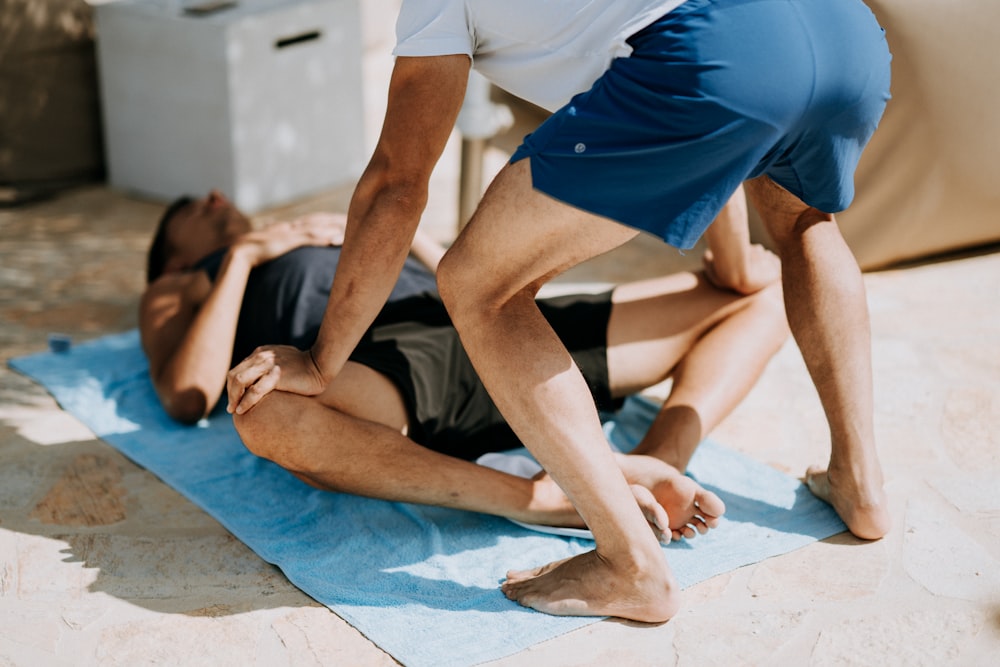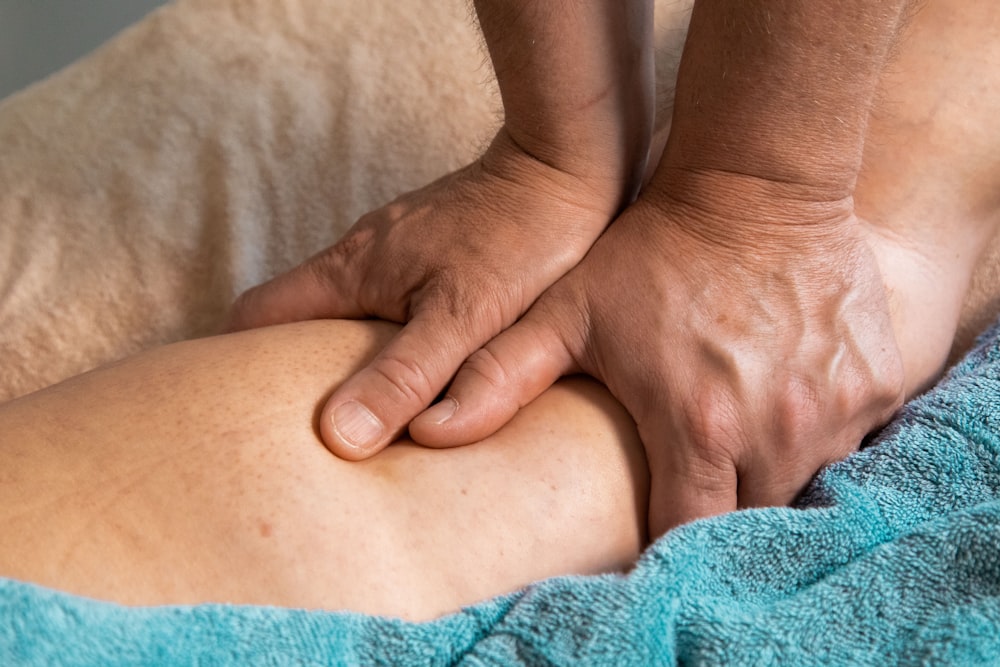Cycling Knee Pain — Understanding and Fixing the Most Common Causes
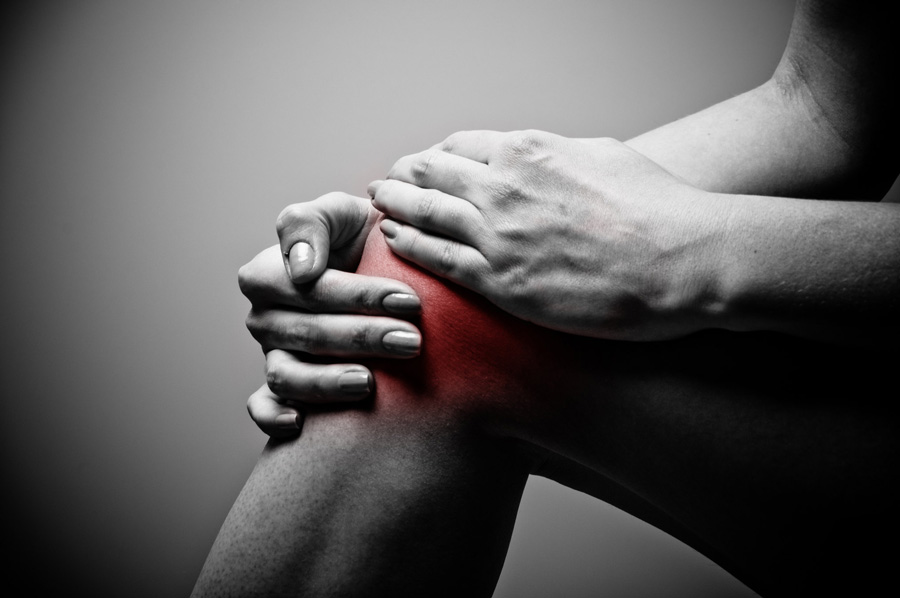
Photo by Esther Max under Creative Commons 2.0
Knee pain is one of the most common injuries in cycling for both competitive and recreational riders. Estimates for the prevalence of cycling knee pain range from 40 to 60 percent in recreational cyclists and 36 to 62 percent in professionals.
Cycling is unique because it is technically a low-impact sport. Low-impact sports put less pressure on the joints, but cycling involves the incredibly high repetition of the pedal stroke (5,400 revolutions per hour), bringing its own set of issues.
You can do various things to prevent, identify, and treat the multiple causes of knee pain and injuries that arise from bike riding. The area is well understood because of the close link between cycling and knee pain.
This article will briefly explain the knee joint, describe common injuries, their causes, symptoms, and how to prevent and manage them.
Understanding the Knee Joint
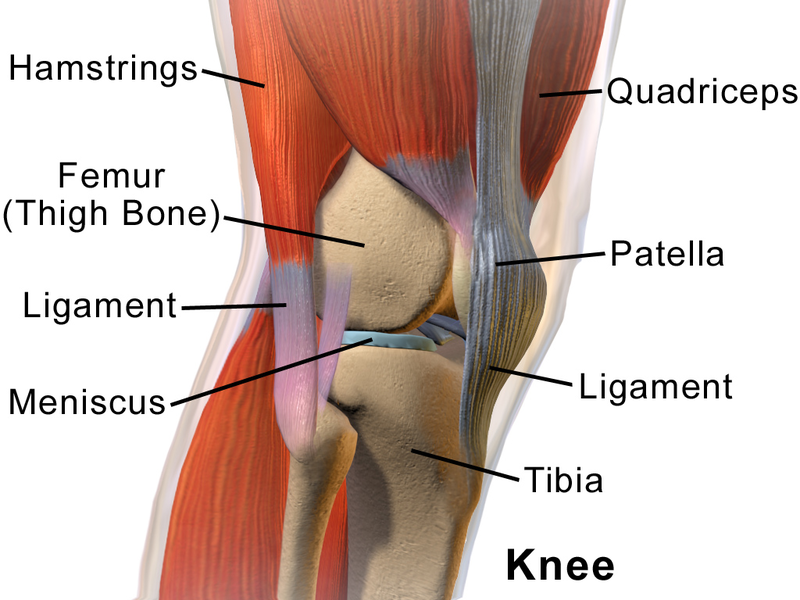
Source: commons.wikimedia.org
The knee, a hinge joint, is one of the most complex joints in the body and the most utilized in cycling.
Four bones meet at the knee, including the femur, patella, tibia, and fibula. Big muscle groups such as the hamstring, calf, shin, and quads all connect around the area. In addition, the TFL (tensor fascia lata) and glutes play a significant role in knee positioning.
When these muscles are overused, they become tight, resulting in added pressure elsewhere in the system.
Although many muscles and bones meet at the knee, most injuries first show symptoms in the connective tissues, the largest of which include:
- Cruciate ligaments – Anterior and posterior ligaments connect the tibia to the femur and stop them from sliding too far backward or forward
- Collateral ligaments – Medial and lateral ligaments on either side of the femur stop it from moving too far on either side
- Patellar tendon – Connect the patella to the quads
- Iliotibial band – Runs from the pelvis to knee and stabilizes the leg, among other functions
- Meniscus cartilage – Tissue that acts as a shock absorber between the leg bones
Connective tissue is particularly susceptible to irritation and damage due partly to the poor blood supply and the less robust structure, meaning repair can take much longer, and damage occurs easier.
The knee goes through an incredible amount of repetitive movements during a bike ride, resulting in repetitive strain injuries instead of tissue tears or strains, as you see in other sports.
Four Main Types of Cycling Knee Pain
This article will categorize knee pain while cycling into four areas: anterior, posterior, lateral, and medial. Using this system, we can take an educated guess at the source of an issue based on where pain shows up.
Anterior: Front Knee Pain
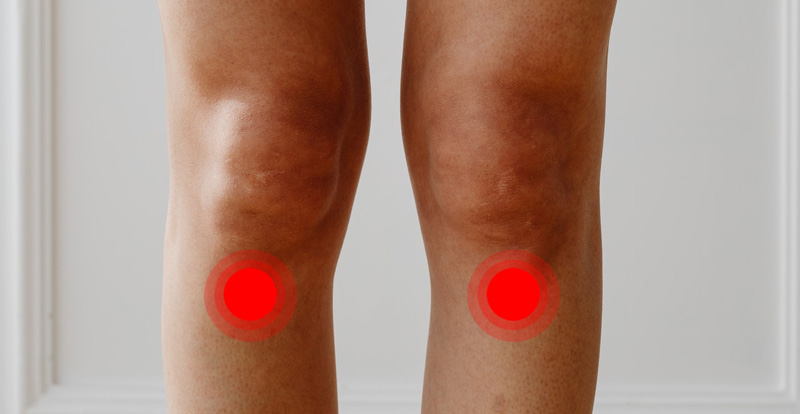
Experiencing front knee pain when cycling is one of the most prevalent injuries cyclists experience. This pain (patellofemoral pain syndrome – PFPS) typically manifests under or around the patella (kneecap).
The quadriceps muscles attach to your anterior shin muscles through the patella, so each time your quad flexes during a pedal stroke, it pulls on the connected muscles and bones.
As a result, if your quads become tight and the skin and fascia (layer of connective tissue surrounding the muscle) become adhered, there can be excess pulling on the patellar tendon, causing it to track poorly.
Additionally, poor leg and knee alignment from bike fit or muscle imbalances can significantly increase the load on the tissues at the front of the knee.
How to Avoid Anterior Knee Pain?
A few issues are known to cause pain in the front of the knee while cycling stemming mostly from bike fit, muscle issues, or training mistakes.
Bike Fit
Firstly, if your saddle is too low or too far forward, you may experience pain from the extra pressure on the anterior knee. Another common problem is crank length; if they are too long, more pressure goes through the front of the knee. Therefore, make sure to do a proper bike fit at home or visit a professional bike fitter.
Weak or Tight Quads
Imbalances from a weak or inactive vastus medialis oblique (VMO) quadriceps can result in anterior knee issues. This muscle can be underdeveloped because the VMO typically activates fully in the final part of a leg extension, and a cyclist’s leg never fully extends while pedaling.
Using the strength training described at the end of this article, you can usually help correct this imbalance.
Tight muscles can also lead to imbalanced pressure distribution, leading to more strain on one area. Cycling disproportionately tightens the mid and lateral quads muscles, possibly causing problems down the line.
Mobilization, stretching, and massage can help improve function and reduce unwanted stiffness in muscles.
Training Mistakes
Finally, a couple of common training mistakes may cause anterior knee injuries.
First, increasing your training load too quickly puts pressure on the muscles and connective tissues before they’re ready. Because these tissues take longer to adapt to training than your cardiovascular system, they require more recovery. To avoid this, increase your training load incrementally, 5-10 percent per week, depending on your experience.
How to Create a Cycling Training Plan
In addition, you can strain the front of your knee by pushing a high gear with a low cadence. A sub 70rpm cadence puts much more pressure on the knee. To avoid this, try to stay between 80 and 100rpm while riding.
Posterior: Back of Knee Pain
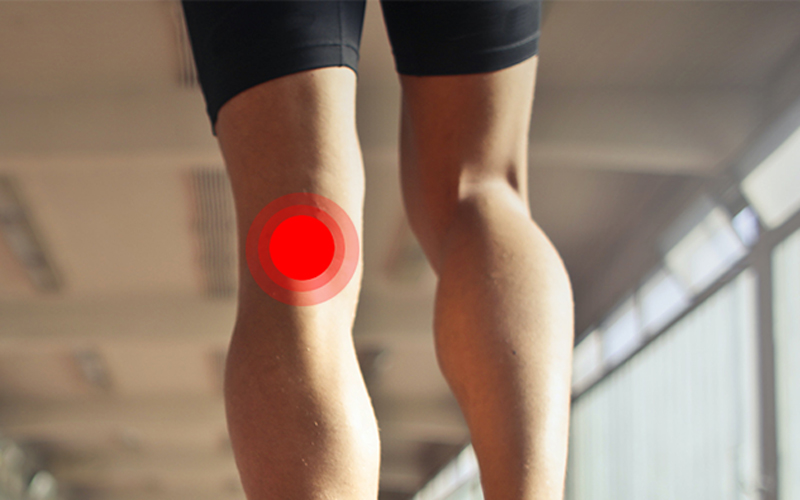
Unlike anterior pain, experiencing back of knee pain from cycling is more straightforward to fix if it stems from a poor bike fit. This pain usually arises from overextension during the pedal stroke, which causes the hamstring muscles to pull excessively.
How to Avoid Posterior Knee Pain?
To avoid pain behind the knee in cycling, check your saddle position. For example, a saddle set too high or too far back can lead to posterior knee issues. Play with your saddle position to try and address this issue or do a professional bike fitting. Additionally, integrate foam rolling and stretching to help relieve symptoms.
Alternatively, if you use a bike with coaster brakes, pedaling backward to stop can strain the hamstrings and result in posterior knee pain. More rest between rides should give your tissues time to adapt to this new movement.
Medial: Inside Knee Pain
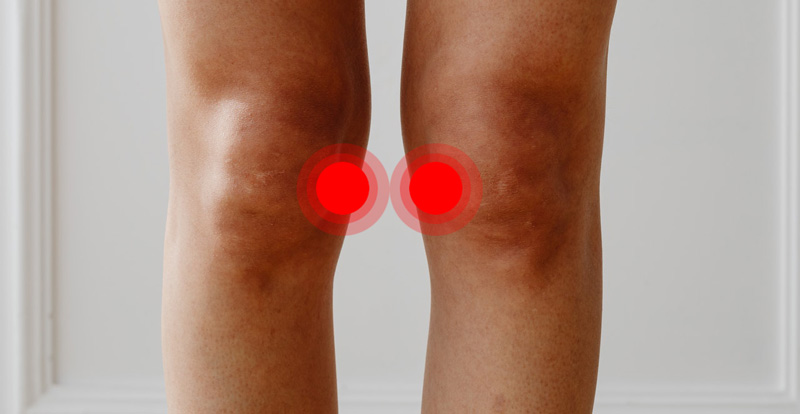
Experiencing medial knee pain from cycling may happen after switching to clipless pedals from platform pedals (toes pointed too far outwards=medial pain). This type of pain usually surfaces soon after the change.
Setting up the pedals correctly for your body is tricky, as a slight change in angle can result in excess pressure on a specific area. In addition, an incorrect Q-factor (distance between your feet) can cause medial knee issues.
Inside knee pain in cycling can also occur from the abovementioned points, including incorrect saddle position, tight quads, or tight adductors. Adductors are the bands running along the inside of your leg that insert at the knee; tightness from excessive sitting may lead to issues at the adductor knee insertion.
How to Avoid Medial Knee Pain?
Set your cleats appropriately, including angle and horizontal position (Q-factor); vertical positioning also matters for other reasons but doesn’t usually cause medial knee pain.
First, angle the cleat so that your toes point straight up or slightly inwards. If that fails, move the cleat horizontally toward the outside of the shoe a few millimeters. If you can’t find a pain-free setting from trial and error, doing a professional bike fit may be necessary. Racking up miles in a poor position can quickly lead to longer-term injuries.
Another factor to consider for cleats is the degree of float allowed; too much or too little float can result in knee pain after cycling. The color of cleats indicates the float—different for each brand. Most casual riders enjoy the comfort of cleats with moderate float, whereas competitive cyclists usually favor 0-degree float options for the performance benefit.
Lateral: Outside Knee Pain
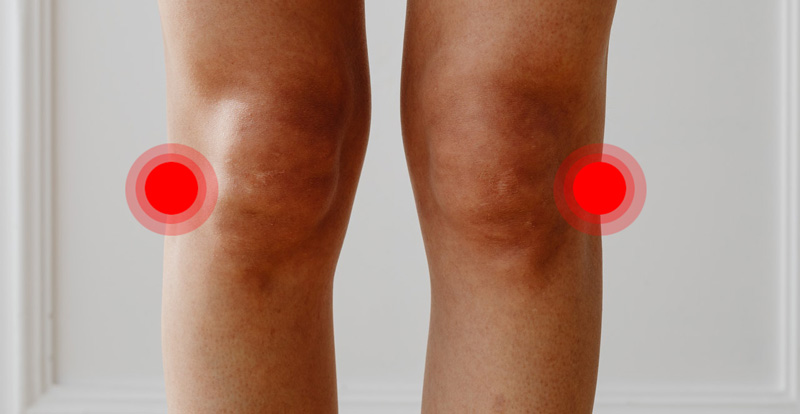
The experience of outside knee pain from cycling is roughly as prevalent as anterior knee pain. Many large muscles and connective tissues meet along the outside of the knee, meaning imbalances or tightness in the muscles above or below frequently manifest as lateral knee pain.
Your cleat and pedal setup is a likely cause of lateral knee pain, especially if discomfort arises upon switching to clipless pedals, buying new bike shoes, or changing cleats.
Illiotibial Band Syndrome
IT Band Syndrome (ITBS) commonly presents as pain in the lateral knee or slightly above, along the thigh. The insertion of the IT band into the knee can become inflamed when the muscles or connective tissues upstream—the lateral quad and hip—become stiff.
Additionally, imbalances in the glute muscles, especially the glute medius, can result in poor knee stabilization during cycling that leads to ITBS.
How to Avoid Lateral Knee Pain?
Again, an incorrect cleat position is a likely culprit. You can try two things: adjust your Q-factor by moving the cleat horizontally toward the inside of the shoe or angle the cleat pointing straight up or slightly outwards.
It’s vital to correct muscle imbalances to address ITBS. You can do this through resistance training exercises for the glute medius, core muscles, and VMO. Otherwise, mobilization tools, isometric stretching, and massage can all reduce tightness in the outer thigh and hip and alleviate lateral knee pain and the symptoms of ITBS.
Common Causes of Cycling Knee Pain
As we’ve seen above, cycling knee pain is often due to a poor saddle or cleat position and a highly repetitive motion in an unaligned position, resulting in extra pressure on the connective tissue.
If pain is not a result of incorrect bike or equipment fit, then stiffness, muscular imbalances, or training mistakes may be the culprits.
Poor Mobility and Tightness
Daily life, exercise, stress, and an array of other factors can contribute to tight muscles and joint stiffness. However, the number one culprit is inactivity, usually from excess sitting. Sitting on soft chairs and couches for work and leisure drastically reduces our body’s natural range of motion.
Additionally, using muscles for exercise causes them to stiffen, so cycling regularly will stiffen the leg, hip, and lower back muscles. Thankfully, as you will see below in the treatment and prevention section, there are several ways we can address stiff muscles and mobility limitations.
Weak Glutes, Core, and Other Muscle Imbalances
The body’s muscular system is completely interconnected, meaning optimal function is dependent on the health of the entire system, not just the areas used directly in an activity.
Muscular imbalances and weaknesses in one area often result in pain elsewhere in the system. For example, a weak gluteus medius and underdeveloped core muscles are associated with knee pain in runners and cyclists due to poor stabilization of the hips, knees, and feet.
Specific to cycling, the core muscles, medial quads, and lateral glutes are mostly disengaged, necessitating off-the-bike strength work to compensate.
Bike Fit Issues and New Gear — Saddle, Shoes, and Cleats
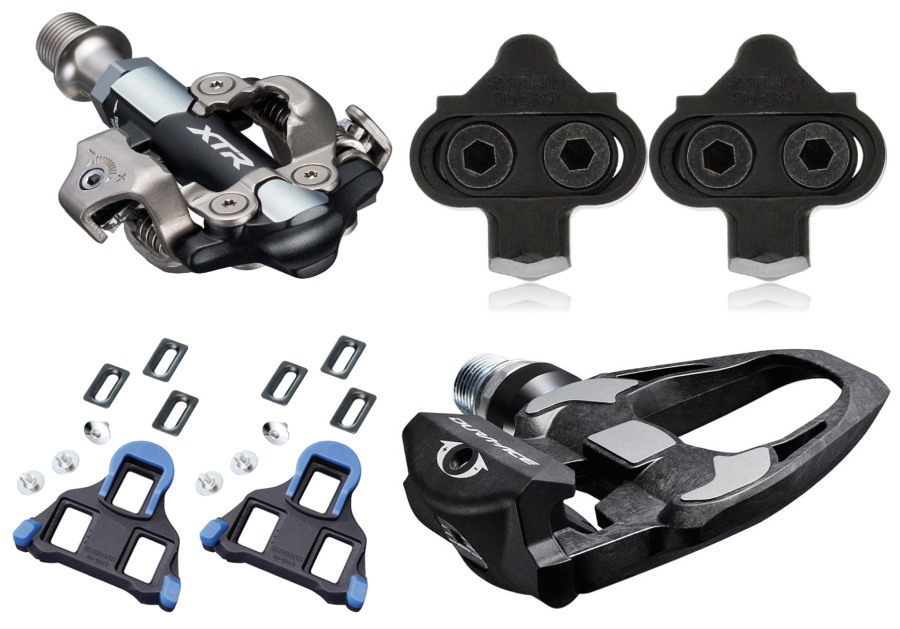
Knee pain in cycling due to cleat position or saddle position is normal. Thankfully, you can address many causes quickly, with minor adjustments doable at home. Nonetheless, visit a professional for an anatomically accurate bike fit that maximizes performance.
If you purchase new shoes, cleats, or even a new bike, you need to set them up to replicate the previous ones; draw a line around your old cleats before removing them. In addition, record the position of your saddle in relation to the bottom bracket and handlebars of your old bike to use as a starting point for setting up a new one.
Make sure that your bike seat is set to the correct height, as a poorly fitted saddle will cause various types of knee pain.
Increasing Training Load Too Fast
Connective tissue takes the longest to adapt, strengthen, and repair following exercise or damage. Therefore, if you increase training hours too quickly, you may develop an overuse injury as your body’s tissues haven’t had time to adapt.
Consider upping your training load in small increments every week or two. For example, you can usually avoid these issues by incrementally adding 5 to 10 percent each period.
Insufficient Rest and Recovery
Concerning the point above, insufficient rest and recovery between training sessions is a sure way to cause damage to your muscles and joints. The stress of cycling (or any exercise) increases the body’s need for good quality sleep and nutrition, so taking a day or two off between hard sessions will help you come back stronger than before.
In addition, many competitive riders use relaxed recovery sessions between harder ones; these rides can promote recovery too. You can also try using a sauna, cold showers, or cross-training to aid recovery and rest.
No Warm-Up
Many cyclists neglect to do a warm-up before riding, which works for some people but provokes injuries in others. Warming up helps increase blood flow, improve mobility, and activate muscle groups before exercising.
Without an appropriate warm-up, you are more likely to injure yourself. Fortunately, as cycling is a low-impact sport, it can be pretty forgiving, but if you have an injury, spending ten minutes warming up pre-ride can be very helpful.
A warm-up for cycling can include low-intensity riding or strength training exercises like those covered below.
Cycling Knee Pain Treatment and Prevention
We’ve mentioned many of these points throughout the article, but here’s a more detailed description of each.
Cadence
Using a high cadence between 80 and 100rpm can help prevent knee pain. Conversely, riding with a low cadence from gearing too high can result in knee pain, especially anterior knee pain from cycling.
How to Shift Gears on a Bike: Gear Shifting Explained for Beginners
Some riders use a specific training method to train power and torque through intentionally using high gears for specified periods during a training session. However, it’s probably best to avoid this type of training if you suffer from knee pain.
Bike Fit
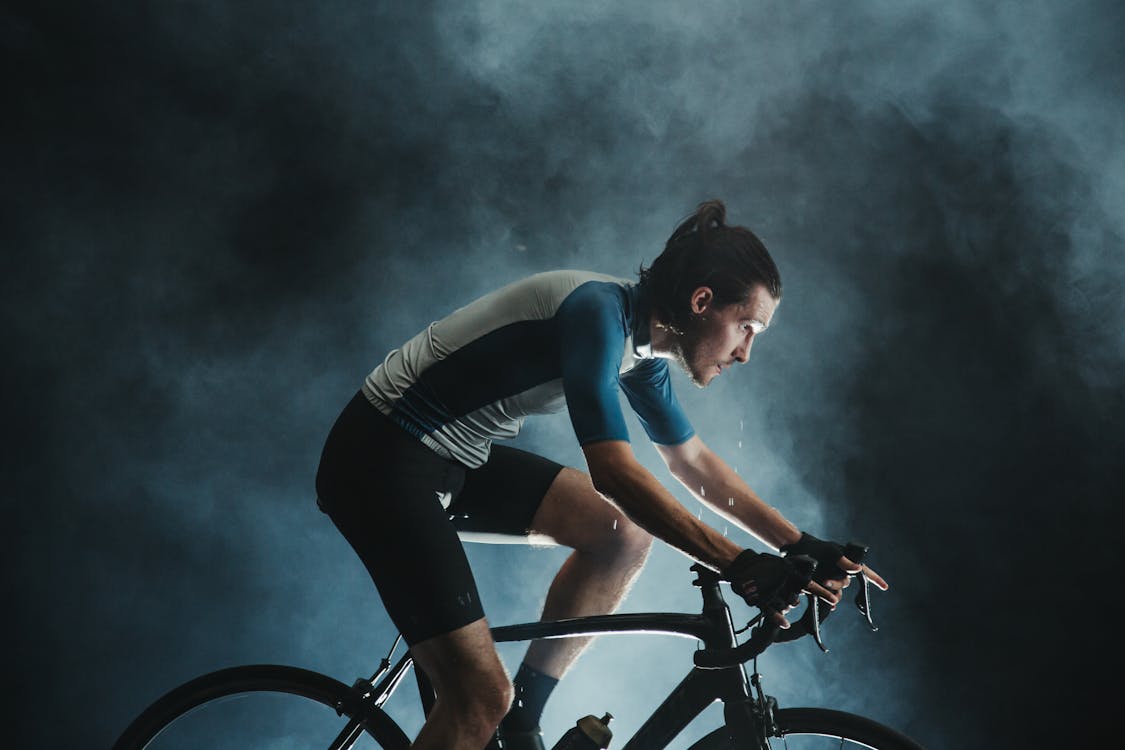
An appropriate bike fit is critical to avoiding knee pain and other cycling injuries. Control, comfort, and power are all optimized through a properly-fit bike. There are many free resources available online, especially on YouTube, that will help you improve your position on the bicycle.
Getting a professional bike fit will always be the best choice, but by following the advice available online, you can usually improve your position by a lot and relieve or completely eliminate cycling knee pain and other issues.
Crosstraining
As cyclists, we love to ride our bikes; however, sticking to one type of exercise can result in overtraining and overuse of specific muscles and joints and the underdevelopment of others. Instead, experiment with various kinds of movement and exercise to help balance out your cycling routine and improve cycling performance.
Excellent activities to pair with cycling include swimming, yoga, pilates, climbing, balance training, and bodyweight resistance exercises.
Mobilization and Massage
As we’ve seen, poor mobility from stiff muscles and joints can lead to knee pain. Regular massage from a professional and self-massage using tools like a roller, tennis/lacrosse ball are excellent ways to boost recovery, reduce muscle sensitivity and soreness, and improve mobility.
Massage helps increase blood flow and hydration to the compressed area, improve how the fascia and skin slide over the muscles, and relieve muscle tension and stiffness. The performance and injury prevention benefits that massage offers are apparent given the high number of masseurs that travel with pro cycling teams.
You can replicate many of the techniques used by a masseuse by using foam rollers and other tools. Choose any follow-along video online to help learn the basics, like those by The Ready State.
Stretching
Active stretching also improves mobility and relieves tight muscles. However, static stretching to warm up pre-ride is ineffective at preventing injury, so save it for recovery days or post-ride. Again, you can find many guided videos on youtube, even ones tailored for cyclists.
Pilates and Yoga
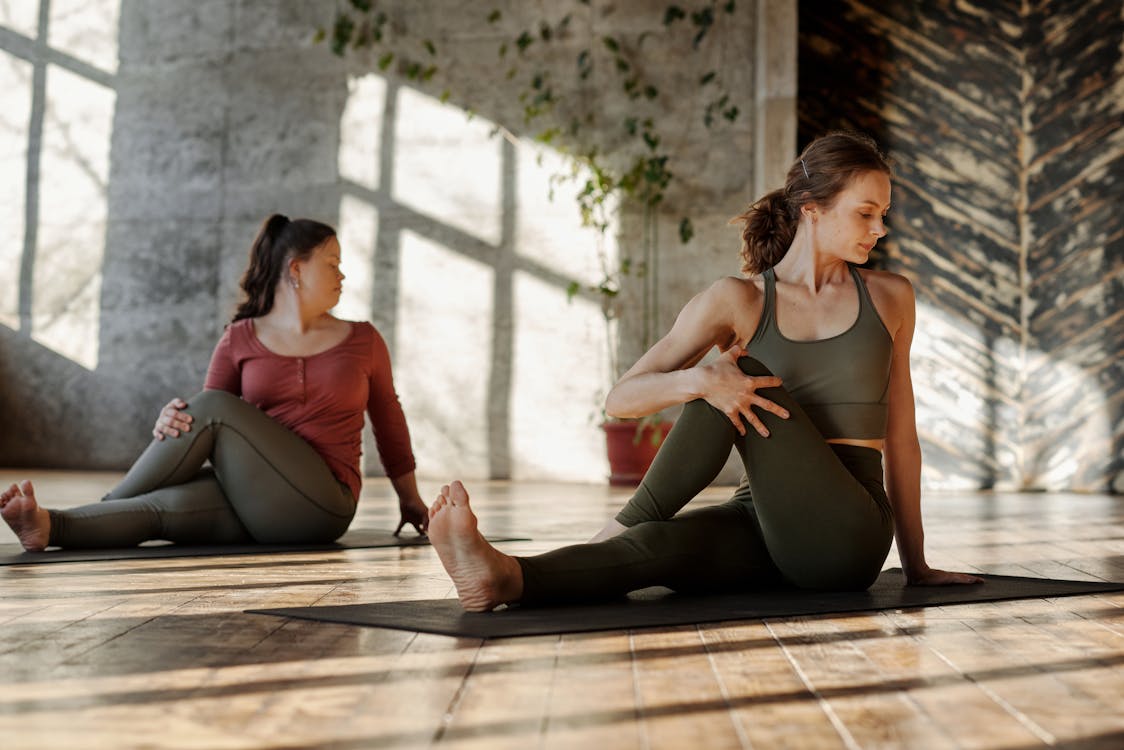
Yoga and pilates are excellent ways to prevent and treat knee issues once done in a guided setting with the relevant progressions available to avoid aggravating your pain.
Both activities integrate mobility, strength, and stability, the perfect supplement bike riding. Athletes across various disciplines practice them regularly, and physiotherapists frequently prescribe pilates for rehab. Pilates, in particular, focuses on core muscle development and activation, which is of great use to cyclists.
Yoga International has a routine for cyclists available on their website. However, there are hundreds of free videos online and classes in almost all cities and large towns.
Physical Therapy
It’s essential to see a physical therapist for any persistent pain stemming from cycling that isn’t resolved by simple adjustments to your setup or routine. These professionals will provide a series of strength and mobility exercises and the appropriate progressions for your body and abilities to help address injuries and pain.
Strength Exercises for Knee Pain
Cyclists struggling with knee pain should begin strength exercises to target neglected muscles, including the gluteus medius, vastus medialis oblique, and stability and core muscles.
Ensure you maintain steady breathing during these exercises, focusing on the activation of the target muscles. Do each one for three or four sets of 10 to 15 repetitions.
Glute Bridge – All Gluteus Muscles
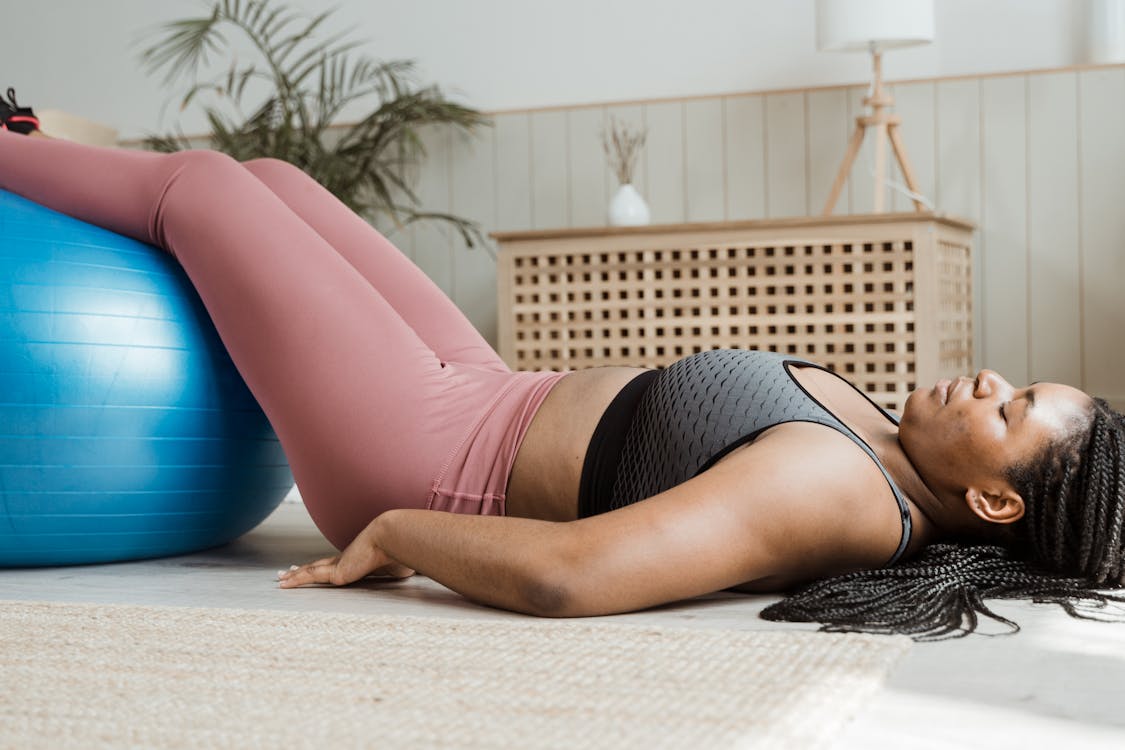
A more difficult variation of glute bridges using a balance ball.
- Lying on your back, lift your legs and place your feet flat on the ground hip-distance apart, bringing your heels in almost to touch your glutes
- Engage your glutes and abs by tucking your butt and tipping your pelvis back, bridging upwards until your body makes a straight line from your knees to your shoulders. Keep your hands flat on the floor
- Slowly lower your whole torso to the floor, maintaining tension in the glutes and core muscles. Repeat once your glutes touch the floor
Standing Leg Abduction – Glute Medius
- Standing up straight with a hand leaning against a wall or table, squeeze your glutes to tuck your butt under
- Abduct your leg away from your body in a straight line, keeping your leg locked out, foot pointed straight, and engaging the glutes throughout
- Once you reach your movement limit, squeeze your glute again, then, slowly and in control, bring the leg back to the center. Repeat
Leg Extension – VMO
- Sit on the leg extension machine, select the appropriate weight, and the height for the lever
- Engage your quads and press your leg up, squeeze at the top with your leg locked out, and slowly lower the weight back down, counting four seconds, repeat
Single-Leg Balancing – Stabilizers, Core, and Leg Muscles
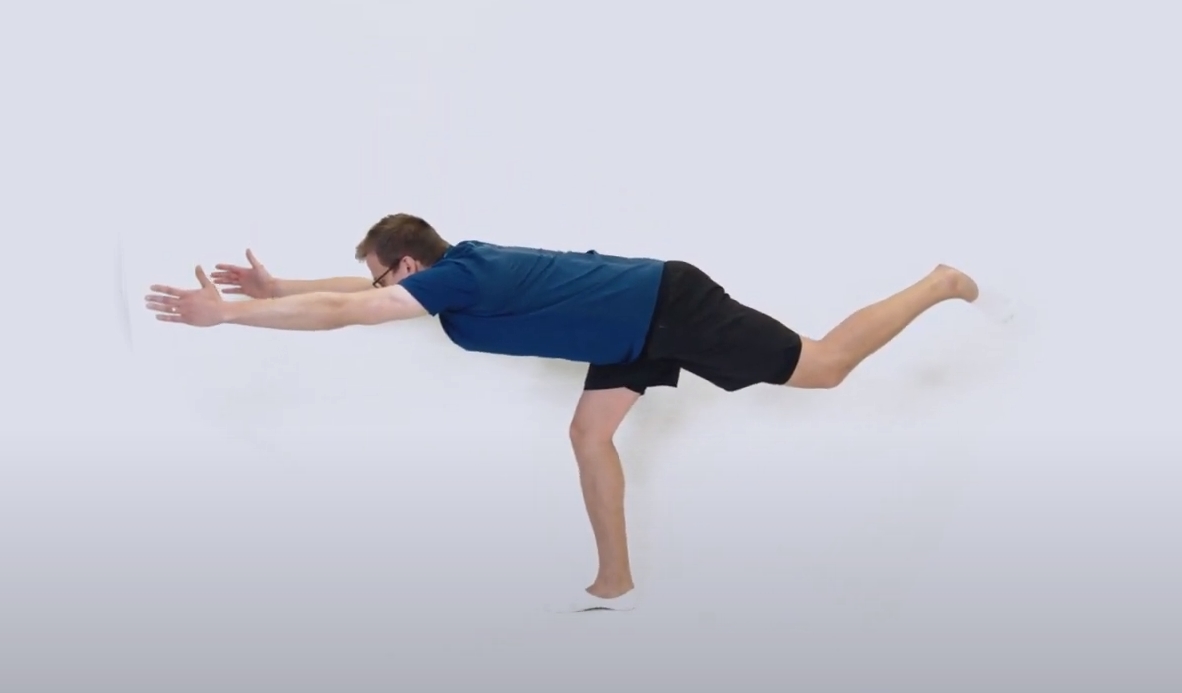
YouTube screenshot — London Back Pain Clinic
- Stand with a slight bend at the knees, feet hip-distance apart, core engaged, and lift one leg to balance on the other
- Keep your knee in line with your foot and hinge at the hips to touch the floor with the opposite hand to the balancing leg. Ensure your knee doesn’t collapse inwards
- Come back up in reverse order, finishing the repetition as the movement started, then repeat (increase the difficulty by increasing knee bend)
Read Next
Shop Recovery & Yoga Accessories on REI
Best Electric Bikes for Seniors
Lower Back Pain from Cycling — Causes, Treatment, and Tips for Prevention


